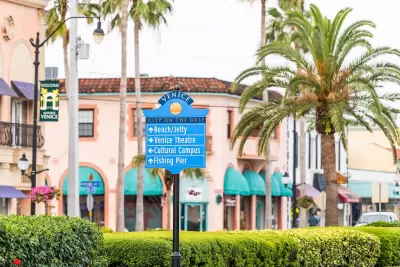How a community planned in the 1920s has gracefully navigated change, offering a model for other places.

In a piece for Governing, William Fulton describes the growth of Venice, Florida, a planned community dating back to the 1920s designed by John Nolen. The community, as Fulton explains, “is one of the most famous and important town plans in American history” for urban planners and designers.
But for Fulton, the magic of Venice isn’t in its original plan; it’s in how the community has evolved and grown through the last century. “It helped me remember that the best places are those that evolve and reinvent themselves over time — a lesson that’s extremely important as we try to figure out the role of places, communities and downtowns in the wake of the pandemic.”
After the Great Depression, the town moved away from Nolen’s original Italianate architecture, adding more Modernist buildings. Since then, the community has embraced its diverse architectural history. Fulton concludes that “Sometimes it’s more valuable to lay down the pattern of public streets and public spaces upfront rather than trying to micromanage private development as today’s planners so often try to do.”
Fulton asks readers to keep Venice’s flexibility in mind as we navigate shifting urban patterns and make decisions about how to build and organize our cities.
FULL STORY: What a Century-Old Planned Community Can Teach Us About Growth

Planetizen Federal Action Tracker
A weekly monitor of how Trump’s orders and actions are impacting planners and planning in America.

Map: Where Senate Republicans Want to Sell Your Public Lands
For public land advocates, the Senate Republicans’ proposal to sell millions of acres of public land in the West is “the biggest fight of their careers.”

Restaurant Patios Were a Pandemic Win — Why Were They so Hard to Keep?
Social distancing requirements and changes in travel patterns prompted cities to pilot new uses for street and sidewalk space. Then it got complicated.

Platform Pilsner: Vancouver Transit Agency Releases... a Beer?
TransLink will receive a portion of every sale of the four-pack.

Toronto Weighs Cheaper Transit, Parking Hikes for Major Events
Special event rates would take effect during large festivals, sports games and concerts to ‘discourage driving, manage congestion and free up space for transit.”

Berlin to Consider Car-Free Zone Larger Than Manhattan
The area bound by the 22-mile Ringbahn would still allow 12 uses of a private automobile per year per person, and several other exemptions.
Urban Design for Planners 1: Software Tools
This six-course series explores essential urban design concepts using open source software and equips planners with the tools they need to participate fully in the urban design process.
Planning for Universal Design
Learn the tools for implementing Universal Design in planning regulations.
Heyer Gruel & Associates PA
JM Goldson LLC
Custer County Colorado
City of Camden Redevelopment Agency
City of Astoria
Transportation Research & Education Center (TREC) at Portland State University
Camden Redevelopment Agency
City of Claremont
Municipality of Princeton (NJ)





























